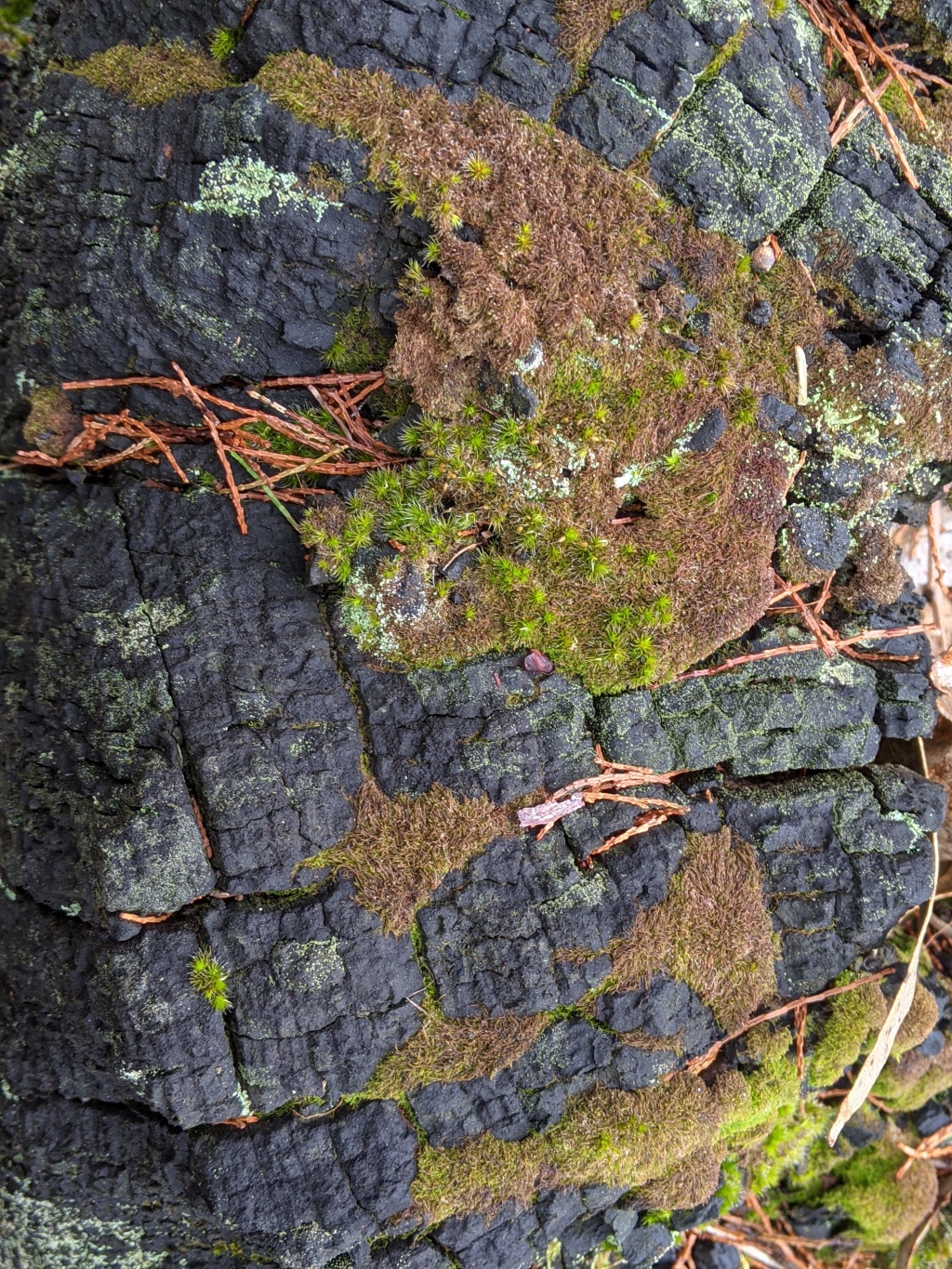Cephaloziellaceae
Terrestrial, lithophytic, including in streams, on logs or epiphytic, dioicous, autoicous or paroicous. Asexual reproduction by 2-celled gemmae produced from margins of reduced and erose appearing leaves near stem apex. Stems all creeping or differentiated into erect stems with normal leaves and creeping stems with reduced or no leaves, irregularly branched, with two ranks of lateral leaves and often a third rank of underleaves; branches emerging from main stem mostly from abaxial stem and with a collar of tissue at base, rarely laterally from stem and with a collar of tissue at base, from near a modified lateral leaf and without a collar of tissue at base or from beside narrower underleaves and without a collar of tissue at base. Lateral leaves quadrate to orbicular, trapezoid, ovate to oblong or obovate (not in Victoria) in outline, unlobed (not in Victoria), retuse (not in Victoria) or bifid, incubous (not in Victoria), transverse or succubous, alternate, strongly appressed to stem and at times hard to distinguish to patently spreading from stem, distant to imbricate, whitish-green, green, chestnut, reddish-brown or purplish-brown, entire or denticulate; lobes triangular, acute or rounded at apex (not in Victoria). Underleaves present or absent, when present bilobed or unlobed and ovate or lanceolate to linear (not in Victoria). Leaf cells irregular-polygonal, rounded-quadrate, oblong or elliptic, smooth, verrucose or papillose, thin- to thick-walled, without trigones, unistratose or bistratose (not in Victoria), with 2–12 oil bodies; oil bodies spherical, ovoid or ellipsoid, finely granular to almost homogeneous, colourless. Rhizoids scattered on stems with normal leaves or mainly scattered on creeping stems with reduced leaves and bases of erect stems, often few, hyaline. Androecium immediately below female bracts, intercalary on main stem of long branches, or sometimes on leafless axes or short branches without normal leaves, with 1–15 pairs of leaf-like but ventricose, each with 1–2 antheridia. Sporophyte terminating stem or long branch with normal leaves or on short branches, developing within a perianth; perianth clavate, obloid, cupulate (not in Victoria) or cylindric, exserted beyond bracts, becoming 3–5-plicate toward mouth, where entire (not in Victoria), crenulate or ciliate; capsule ellipsoid or ovoid, 2–4 stratose, dehiscing by 4 valves; elaters 1–2-spiral; spores smooth, verruculose, granulate (not in Victoria) or areolate (not in Victoria).
Cosmopolitan with eleven genera and around 130 species (Schuster 2002; Mamontov & Vilnet 2017); three genera in Victoria.
Söderström et al. (2016) followed Váňa et al. (2013) in recognising a broad circumscription of Cephaloziellaceae that Váňa et al. (2013) divide into a core group of Cephaloziellaceae, that includes Cephaloziella and Cephalomitrion among the Victorian genera (Váňa et al. 2013), and those outside the core group, including Victorian Allisoniella, Anastrophyllopsis, Chaetophyllopsis, Nothogymnomitrion and Protolophozia (Váňa et al. 2013; Bakalin et al. 2024). However, under this broad circumscription, the Cephaloziellaceae is a morphologically heterogeneous assemblage of genera, and no phylogenies strongly support a close relationship between any of the genera Váňa et al. (2013) transferred to Cephaloziellaceae, and Cephaloziella and the genera of their core Cephaloziellaceae.
Molecular phylogenies published since Váňa et al. (2013) reiterate their ill-founded circumscription of Cephaloziellaceae. In the molecular phylogeny of Shaw et al. (2015), Anastrophyllopsis and Nothogymnomitrion were more closely related in one analysis to Lophoziaceae and Scapaniaceae than they were to Cephaloziellaceae, and in the chloroplast phylogeny of Gradstein et al. (2014), Chaetophyllopsis forms a group with Andrewsianthus, and the relationship of this group to Anastrophyllaceae and Cephaloziellaceae is unresolved. Váňa et al. (2013) conceded that their broad Cephaloziellaceae should probably be separated into further families, which is how this group of genera will be treated here. The Cephaloziellaceae here follows the much narrower circumscription presented by Schuster (2002) based on morphological coherence and capsule-wall ontogeny. This circumscription also appears to form a group in chloroplast phylogenies (Gradstein et al. 2014).
Bakalin, V.A., Maltseva, Y.D., Klimova, K.G., Nguyen, V.S., Choi, S.S. & Troitsky, A.V. (2024). New insight into the taxonomy of Cephaloziellaceae (Marchantiophyta): the family of the smallest higher plants on Earth. Frontiers of Plant Science 15:1326810.
Gradstein, S.R., Laenen, B., Frahm, J.-P., Schwarz, U., Crandall-Stotler, B.J., Engel, J.J., von Konrat, M., Stotler, R.E., Shaw, B. & Shaw, A.J. (2014). On the taxonomic status of the enigmatic Phycolepidoziaceae (Marchantiophyta: Jungermanniales) with description of a new species, Phycolepidozia indica. Taxon 63: 498–508.
Mamontov, Y.S. & Vilnet, A.A. (2017). Cephaloziella konstantinovae (Cephaloziellaceae, Marchantiophyta), a new leafy liverwort species from Russia and Mongolia identified by integrative taxonomy. Polish Botanical Journal 62: 1–19.
Schuster, R.M. (2002). Austral Hepaticae Part II. Nova Hedwigia Beiheft 119. Cramer in der Gebrüder Borntraeger Verlagsbuchbehandlung: Berling & Stuttgart.
Shaw, B., Crandall-Stotler, B., Váňa, J., Stotler, R.E., von Konrat, M., Engel, J.J., Davis, E.C., Long, D.G., Sova, P. & Shaw, A.J. (2015). Phylogenetic relationships and morphological evolution in a major clade of leafy liverworts (Phylum Marchantiophyta, Order Jungermanniales): Suborder Jungermanniineae. Systematic Botany 40: 27–45.
Söderström, L., Hagborg, A., von Konrat, M., Bartholomew-Began, S., Bell, D., Briscoe, L., Brown, E., Cargill, D.C., Costa, D.P., Crandall-Stotler, B.J., Cooper, E.D., Dauphin, G., Engel, J.J., Feldberg, K., Glenny, D., Gradstein, S.R., He, X., Heinrichs, J., Hentschel, J., Ilkiu-Borges, A.L., Katagiri, T., Konstantinova, N.A., Larraín, J., Long, D.G., Nebel, M., Pócs, T., Puche, F., Reiner-Drehwald, E., Renner, M.A.M., Sass-Gyarmati, A., Schäfer-Verwimp, A., Moragues, J.S., Stotler, R.E., Sukkharak, P., Thiers, B.M., Uribe, J., Váňa, J., Villarreal, J.C., Wigginton, M., Zhang, L. & Zhu, R. (2016). World checklist of hornworts and liverworts. Phytokeys 59: 1–828.
Váňa, J., Söderström, L., Hagborg, A. & von Konrat, M. (2013). Notes on early land plants today. 40. Notes on Cephaloziellaceae (Marchantiophyta). Phytotaxa 112: 1–6.
 Spinning
Spinning